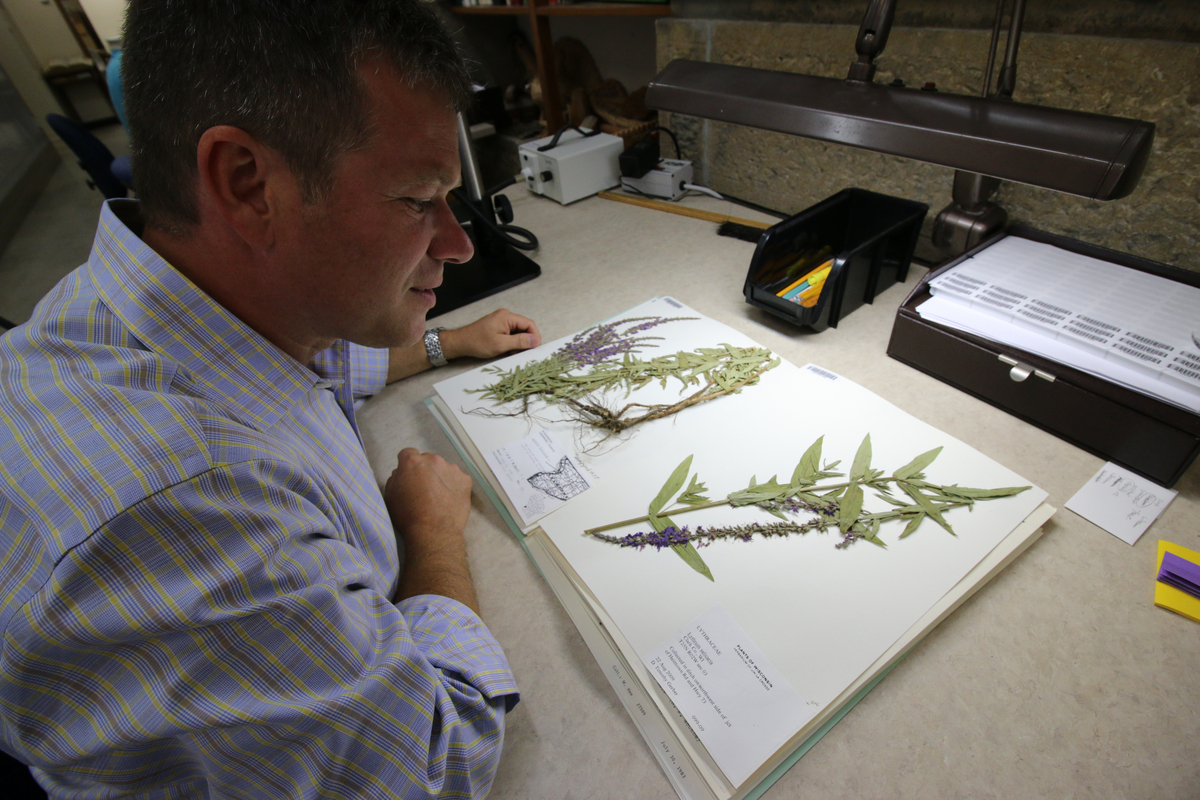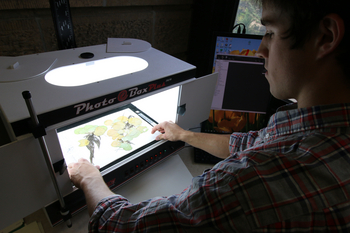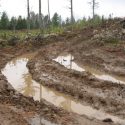Project prepares collection for 21st-century challenge of invasive species

Kenneth Cameron, director of the Wisconsin State Herbarium, examines a dried specimen of purple loosestrife, one of the invasive Great Lakes plants being digitized with support from the National Science Foundation.
Photos: David Tenenbaum
UW-Madison sophomore Alex Idarraga carefully feeds a paper sheet holding a pressed, dried plant into a light box, closes the door and triggers the camera mounted overhead.
Each click of the shutter moves the Wisconsin State Herbarium where he works one step closer to a long-sought goal: entering photos of its plant specimens into a database together with information on the collector, collection date and location.
An herbarium is like a library of plants, and the herbarium at the University of Wisconsin–Madison botany department has one of the largest libraries in the country, holding more than 1.2 million specimens collected primarily in the Americas.
As the name implies, the herbarium has the world’s largest collection of Wisconsin plants. And Wisconsin, with more than 1,000 miles of shoreline along two Great Lakes, is ground zero in the ongoing transformation of lakes great and small by exotic species — invaders that come from different places and prosper in waters that lack natural controls and predators.

UW-Madison student Alex Idarraga photographs a plant invading the Great Lakes basin.
Half of the Wisconsin population lives in the Great Lakes basin, defined as land that drains in Lake Michigan or Lake Superior.
At the herbarium, director Kenneth Cameron is spearheading a new, three-year project to “digitize” images and data on aquatic and wetland plants, mollusks and fish from the Great Lakes basin. The $2.5 million grant from the National Science Foundation will also be disbursed to natural history museums at UW campuses in Stevens Point, Milwaukee and La Crosse, and in every other Great Lakes state.
Together, these institutions expect to digitize 1.73 million specimens related to Great Lakes invasives. The project has targeted 2,550 species, including known invaders and their close relatives.
At least 180 nonindigenous species are living and reproducing in the Great Lakes basin, and many wreak havoc. Old invaders, like the zebra and quagga mussels, already have had enormous economic and environmental impacts, even as new ones knock on the door, like the Asian carp now nearing Chicago. The new project will not fund data analysis, and therefore will not directly slow the tide, “but the more information we can put out there, the better,” Cameron says.
Access matters, adds Cameron, a professor of botany. “It’s kind of a shame that we have museums and herbaria sitting on such a treasure trove. Anybody can use it, but only if they know about it. We want to get the data out.”
A second goal is to harness the explanatory power resident in those collections to document species invasions, with an eye, eventually, toward prevention. The digitized data will shed light on the movement of invasives, Cameron says.
“Our collections go back more than a century, and spread far beyond the state,” says Cameron, “so we will be able to track the arrivals back to their origin. That should help us prepare for new ones, or better yet, to prevent them.
“In this genomic age, natural history museums may be viewed as Victorian, antiquated, a discipline that’s no longer relevant, but people are coming to realize that our collections are irreplaceable snapshots in space and time. Now we can capture the genetics of organisms in our collections, and suddenly, using these large sets of species data is recognized as legitimate, 21st-century science.”

Laura Halverson Monahan, curator of the UW–Madison Zoological Museum, holds a jar containing a common carp.
Laura Halverson Monahan is curator of the UW-Madison Zoological Museum, which will digitize relevant fish and mollusks from its collection. She hopes making the data available will raise her museum’s profile and make it more useful to the scientific community.
“We have a modest collection, nearly 750,000 specimens, but we have this collection so people can use it, study it. Now, if someone wants to borrow fish, we have to remove all of them from the jar, wrap them, package them with an industrial Seal-a-Meal, then send them off. Once we have the image and data online, scientists will find it easier to choose the best specimens remotely, and that makes things better for everybody.”
Ultimately, Cameron says, “I hope people will realize that invasives have been with us for a long time, but their rate of spread is accelerating, and our collections can document that. That may create a greater sense of urgency and concern.”


